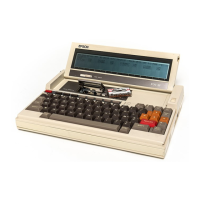REV.-A
2.7.2
Key
Signal
Input
The keyboard has a 9 x 8 matrix structure
which
uses nine keyboard scan (KSC) signals and
eight
keyboard return (KRTN) signals. The scan signals are used
as
a reference and a pressed key is
identified by examining the corresponding return signal lines
for
make.
Key
input
is controlled by the
4-bit
sub
CPU
7508
which
is programmed
to
read, when
the
com-
puter is initialized, the setting
of
the
DIP
SW2
assembly,
as
well
as
the key switches. The read key
data and
the
SW2
setting are bit-serially transferred
to
the
IC
4C (GAH40M), where the data are
converted
from
serial
to
parallel, and further transferred
to
the main
CPU.
Fig.
2-68
is a block dia-
gram
of
the keyboard matrix.
r--'
A
~
1
1
L
7
r
B
1
1
~
5
I
1
"
C
lE
1
1
IJ
KSeQ - 8
0
1
I
1
1
8
D
'i
1
1.
(2E)
I
I"
KRTN
0
~
7
1
I
1
~
47K
I
I
-AAA
_ +5
1
I
I
.1.
•••
1
I
..J
I
1
~
I
1
VI
47K
~
+5
I
I
1
I
I
1
1
"I
.A
+5
I
VI
I
47K
L_J
> r
~
MAPLE board
Keyboard
...
:;0.
CN4
Fig.
2-68
Keyboard
Matrix
Normally,
IC
1 E maintains all the
KSC
signal lines
at
the
low
level. Pressing a key causes a current
to
flow
from
the corresponding
KRTN
signal line on the MAPLE board
to
the
IC
through the
diodes, pulling the
KRTN
signal line low.
7508
can detect
that
a key is pressed
from
the level
change
of
the
KRTN
signal line. However,
it
cannot identify the pressed key
which
turned the line
low. To accomplish
this
identification, the
7508
monitors
the
KRTN
signal line
while
outputting
pulses over the
KSC
signal lines
as
shown
in
Fig.
2-69.
By examining both
the
KRTN
signal line
turning
low
and the
KSC
signal line, over
which
a negative going pulse is currently output, the
7508
is able
to
identify
which
key has been depressed.
2-68

